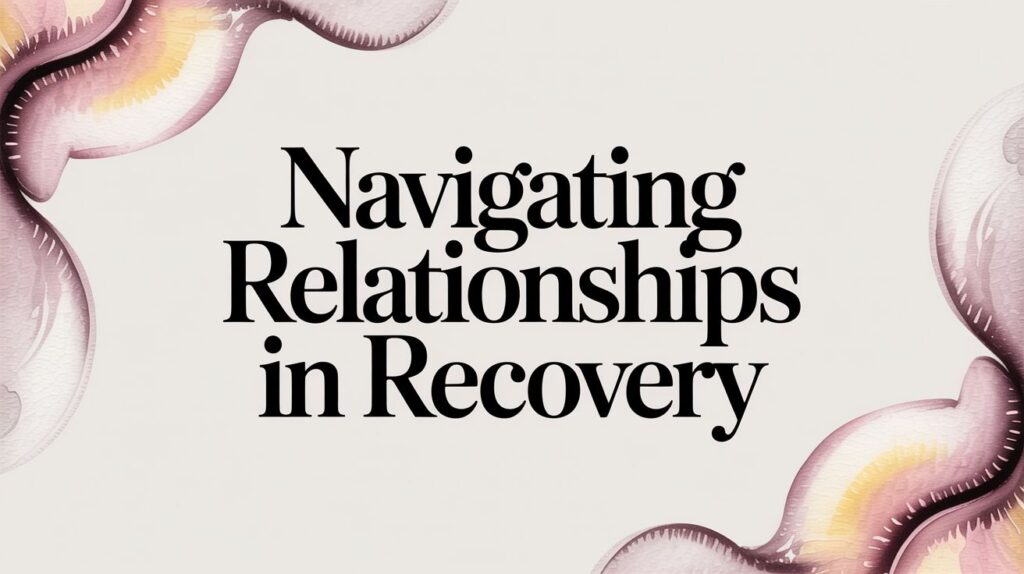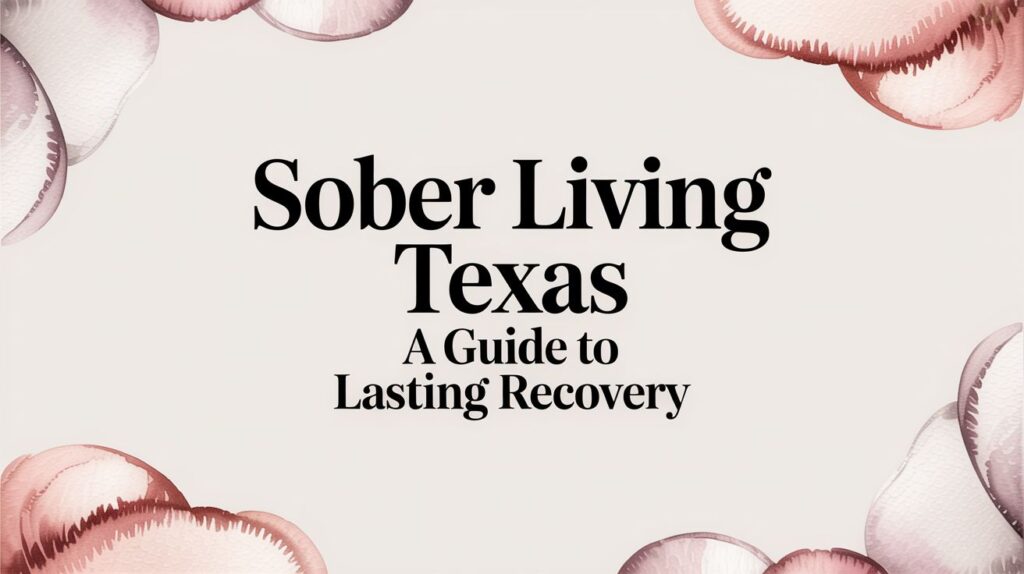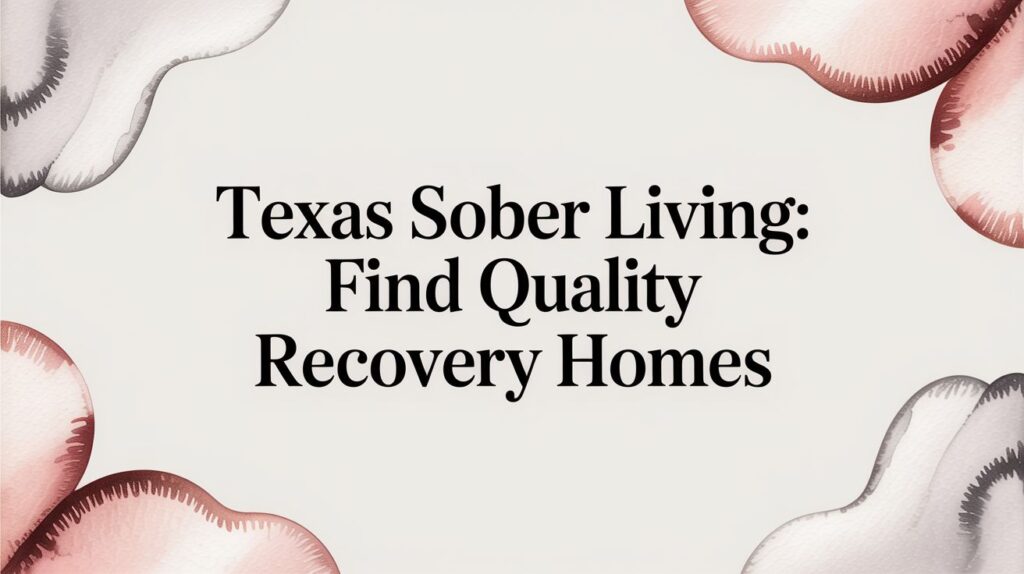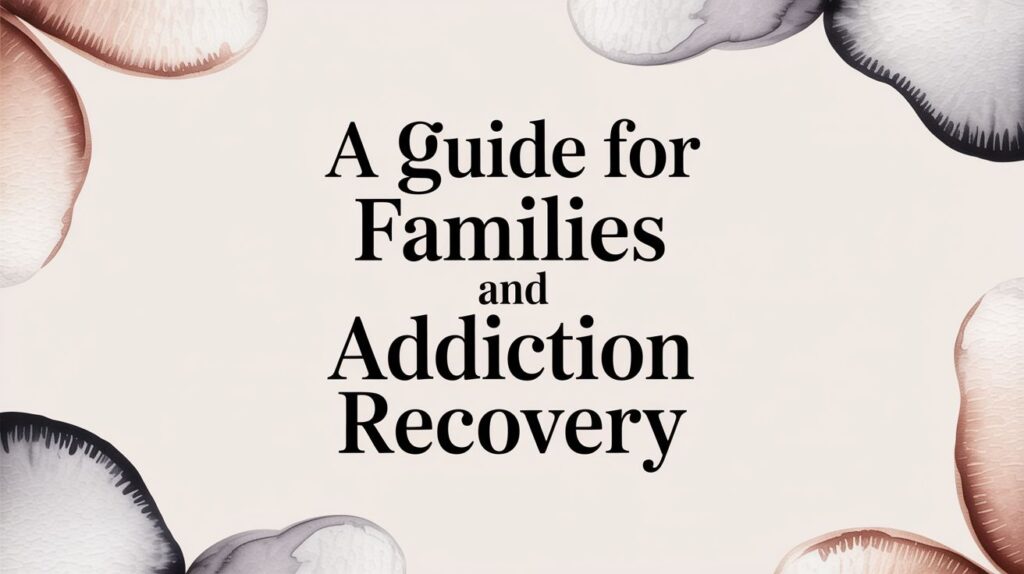Setting healthy boundaries is all about drawing a line in the sand to protect your time, energy, and well-being. It’s a powerful act of self-respect that clearly tells others what you will and won’t accept, creating a solid foundation for more honest and healthy relationships.
Why Setting Boundaries Feels So Hard (And Why It's Worth It)
Let's be real: the simple act of telling someone "no" can feel like a monumental task.
The fear of letting down a family member, coming across as difficult at work, or even losing a relationship can stop us dead in our tracks. This isn't some personal flaw; it’s a deeply human struggle rooted in our desire to be liked and keep the peace.
Many of us were taught to put others' comfort before our own needs, making us feel like setting a boundary is a form of rejection. We carry this quiet fear that if we don't give our time and energy exactly how people expect, we're a disappointment. This can lock us into a cycle of people-pleasing that leaves us feeling exhausted, resentful, and completely disconnected from ourselves. For some, these deep-seated patterns are tied to past experiences, and exploring what is trauma-informed therapy can shed light on why these reactions feel so automatic.
The True Purpose of a Boundary
It helps to stop thinking of boundaries as rigid walls meant to keep people out. Instead, see them as essential tools for self-respect that actually strengthen your connections.
Think of your energy as a finite resource, like money in a bank account. Every single interaction, task, and commitment you make is either a deposit or a withdrawal. Without clear limits, it’s frighteningly easy to overdraw your account, leading straight to burnout.
A boundary is a form of self-love and respect that communicates to others what, where, and how much of your energy you’re willing to give away. It’s about protecting your well-being, not controlling or punishing others.
This infographic does a great job of showing how boundaries act as a protective shield across all the different parts of your life.
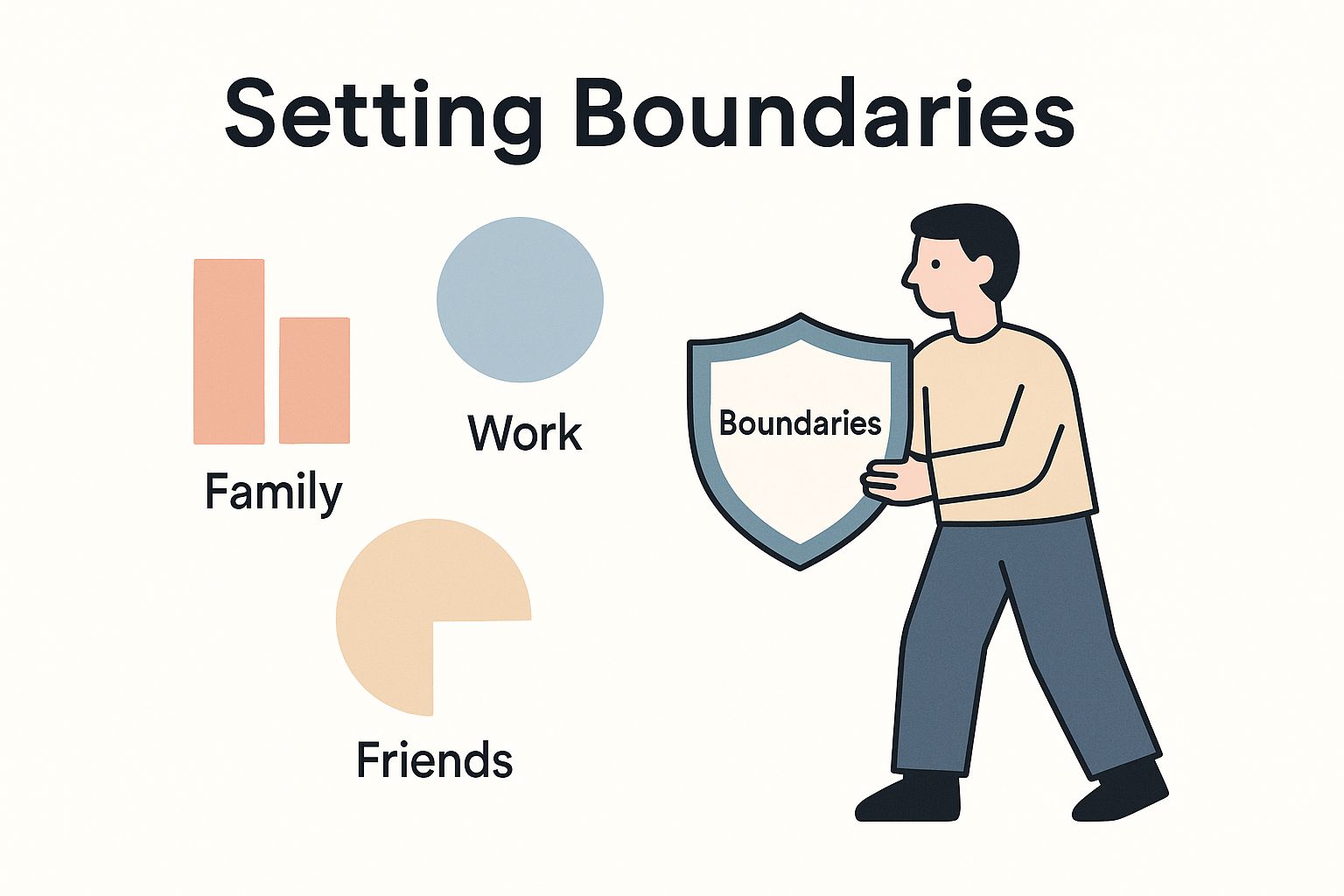
As the image shows, setting these limits in your professional, personal, and family life is what creates a balanced and protected personal space.
The Long-Term Reward
Pushing through that initial discomfort of setting a limit pays off in massive ways. At work, it’s one of the biggest factors in preventing burnout. In fact, one study found that 57% of "quiet quitters" said their work-life balance improved dramatically after they started setting clear boundaries. You can dig into how professionals are reclaiming their time in this insightful report.
Ultimately, setting boundaries is the first step toward building relationships based on mutual respect instead of quiet, resentful obligation. It frees up your mental and emotional bandwidth, allowing you to show up as your best self for the people and passions that truly matter.
Discovering Where You Need Boundaries Most
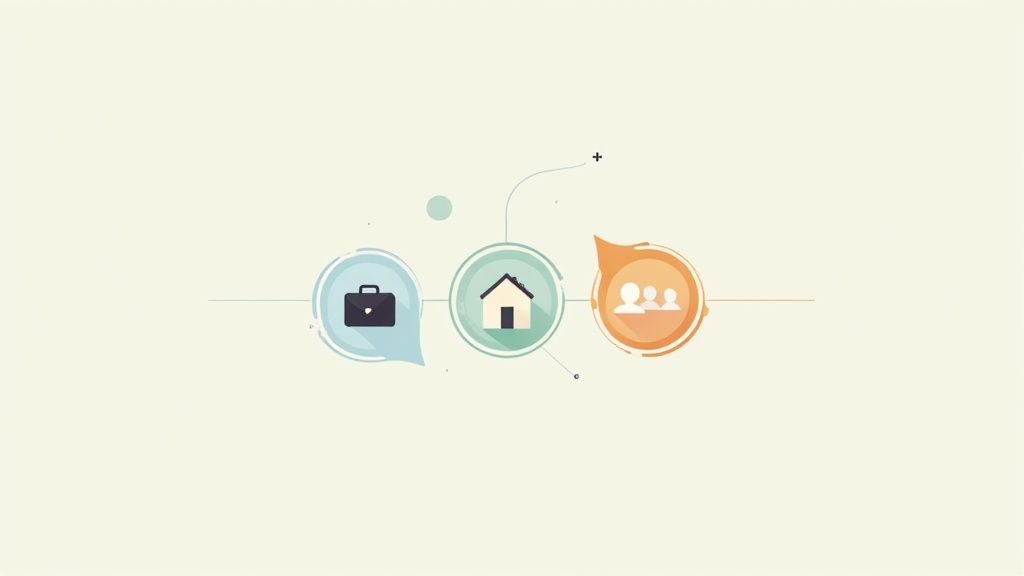
Before you can build a strong fence, you have to walk the property line. The same goes for personal boundaries. You first need to understand your own landscape—the specific places where your energy and goodwill are leaking out. Getting good at setting healthy boundaries always starts with this critical step of self-discovery.
Think of your emotions as a built-in alarm system. Feelings like resentment, bone-deep exhaustion, or that nagging sense of being taken for granted aren't just bad moods. They're signals. More often than not, these feelings point directly to a spot where a boundary has been crossed or is missing entirely.
Do you feel a flash of irritation every time a certain coworker pings you after 6 PM? That's a signal. Do you feel completely drained and resentful after every phone call with a particular family member? That’s another one. Recognizing these emotional flares is the first step in creating your personal "boundary map."
Tuning Into Your Internal Compass
To start mapping these areas, you need to get quiet and just listen. This isn't about blaming anyone else; it's about honestly assessing how different interactions and requests actually affect you. The goal is to become keenly aware of what depletes you versus what energizes you.
Try this simple reflection exercise for just one week:
- Do a Daily Check-In: At the end of each day, take five minutes to mentally scroll through your interactions. Think about conversations, tasks, and requests you handled.
- Spot the Energy Drains: Pinpoint one or two moments that left you feeling tired, annoyed, or overwhelmed. Was it that last-minute project your boss dropped on your desk? A friend who vented for an hour without asking how you were?
- Name the Feeling: Put a label on the emotion tied to that moment. Was it frustration? Guilt? Feeling invisible? Just naming the feeling brings a ton of clarity and shows you exactly where a limit is needed.
This simple practice trains you to recognize your own needs in real-time. You'll start shifting from a reactive state of burnout to a proactive state of self-protection.
Boundaries are simply the limits that identify what you are okay with and what you aren’t okay with. They are essential for recognizing what is yours to own and what you’re responsible for in your life.
Ultimately, this process is about protecting your two most valuable resources: your time and your energy. When you guard them, you create the capacity to show up as your best self in every part of your life. In especially tough relationship dynamics, like when https://alturarecovery.com/blog/dealing-with-alcoholic-spouse, this awareness becomes absolutely essential for your own well-being.
Mapping the Different Types of Boundaries
Boundaries aren't one-size-fits-all. They come in several flavors, and you might need Fort Knox-level security in one area and a white picket fence in another. Understanding the different types helps you get specific and effective when setting them. For more ideas, some great resources offer a ton of examples of healthy relationship boundaries that can strengthen your connections.
To get started, it helps to see where your needs fall. This table breaks down the main categories so you can start mapping out where you might need to reinforce your lines.
Mapping Your Personal Boundary Needs
This table can help you identify the different categories of personal boundaries and what they look like in real life.
| Boundary Type | What It Protects | Example of a Weak Boundary | Example of a Healthy Boundary |
|---|---|---|---|
| Emotional | Your feelings and mental energy. | Taking on a friend’s anxiety as your own or feeling responsible for their happiness. | "I can listen and support you, but I can't solve this for you. I need to protect my own peace." |
| Physical | Your personal space, body, and physical comfort. | Hugging a relative you're not close to just to avoid awkwardness. | "I'm not much of a hugger, but I'd love to shake your hand." |
| Time | Your schedule, priorities, and free time. | Automatically saying "yes" to every request, leaving no time for yourself. | "Thank you for thinking of me, but I can't commit to that right now as my schedule is full." |
| Digital | Your online interactions and availability. | Feeling obligated to respond to work emails or texts at all hours of the day and night. | Turning off notifications after 6 PM and communicating that you'll respond the next business day. |
Looking at these examples, you can probably already spot a few areas that feel familiar. That's a great starting point. The next step is learning how to communicate these needs clearly and kindly.
How to Communicate Your Boundaries with Confidence
https://www.youtube.com/embed/vlwmfiCb-vc
Figuring out where you need a boundary is one thing. Actually saying it out loud? That’s where most of us get stuck.
Let's be real: the fear of sounding demanding, selfish, or aggressive is a powerful silencer. But communicating your needs doesn't have to be a big, dramatic confrontation.
With the right game plan, you can learn to set healthy boundaries with confidence, clarity, and even kindness. It's all about shifting the focus from blame ("You always do this!") to a simple statement of your own needs. This isn't about controlling someone else; it's about stating what you'll do to protect your own peace.
Use the "I Feel, When, I Need" Framework
One of the most effective tools I've seen in my practice is the "I feel, when, I need" statement. It’s a simple formula, but it’s pure gold for keeping a conversation on track.
This approach centers the conversation on your experience, which makes it much harder for the other person to feel attacked or get defensive. You're not accusing; you're explaining.
Here’s the breakdown:
- I feel… Start by naming the emotion. (e.g., "I feel overwhelmed…")
- When… Describe the specific, observable behavior. (e.g., "…when I get work calls after 7 p.m.")
- I need… Clearly state the change you require. (e.g., "…I need to keep work talk to business hours so I can recharge.")
Put it all together, and it sounds like this: "I feel overwhelmed when I get work calls after 7 p.m. I need to keep work talk to business hours so I can recharge." It’s firm, clear, and doesn't point a single finger.
Practical Scripts for Tricky Situations
Sometimes, the hardest part is finding the right words in the moment. Having a few pre-planned scripts in your back pocket removes that pressure and helps you stay calm.
Scenario 1: Telling your boss you can't work late (again).
Instead of making up a vague excuse, be direct and respectful.
"I know this project is a top priority, but I'm committed to being home on time tonight. I'll be ready to tackle this first thing in the morning with a fresh set of eyes."
Scenario 2: Asking a friend for some space.
Honesty doesn't have to be hurtful, especially when you're feeling drained.
"I really value our friendship, but I'm feeling pretty depleted right now and just need some quiet time to myself. Can we please reschedule for next week?"
Scenario 3: Managing an overbearing relative's unsolicited advice.
You can acknowledge their good intentions while still holding your ground.
"I appreciate that you're trying to help, and I know you mean well. My partner and I feel confident in the decisions we're making, and we aren't looking for advice on this right now. But I'd love to hear about…"
Learning to say no gracefully is a core skill, especially in the workplace. For more proven scripts and advice, check out these strategies for saying no at work without guilt to help you reinforce those professional limits.
The Importance of Tone and Timing
Here’s the thing: how you say something is often more important than what you say. Your goal is to be heard, not to win a fight.
A calm, neutral, and firm tone of voice signals that you're serious but not looking for a battle. Try practicing your boundary statement out loud. Hearing it yourself is a great way to fine-tune your delivery.
Timing is also everything. Bringing up a boundary in the middle of a heated argument is a recipe for disaster. When emotions are high, nobody is listening. Wait for a quiet moment when you both have the mental space for a real conversation. This simple act of respect makes it far more likely your boundary will be, too.
Sometimes, our communication patterns are tangled up with deeper motivations. Understanding these drivers can be a game-changer. Learning about different therapeutic approaches, like discovering what motivational interviewing therapy is, can offer powerful insights into aligning your actions with your goals for healthier relationships.
Remember, setting a boundary is a gift—to yourself and to the relationship. It replaces resentment with respect and builds a foundation for more honest, sustainable connections.
Handling Pushback and Staying Consistent
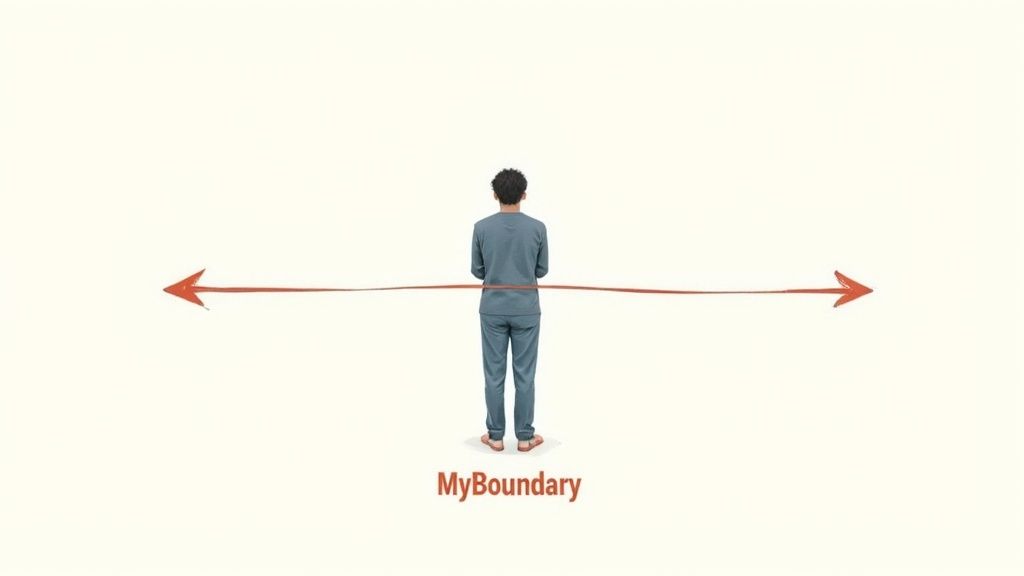
Setting a boundary is a huge first step. But the real work begins when you have to hold that line against resistance. And trust me, there will almost always be resistance.
This is completely normal. When you change the unspoken rules of a relationship, you can expect some pushback from people who were comfortable with the old dynamic.
They might not be doing it to be malicious. Sometimes, it’s just habit or a genuine misunderstanding. But other times, you'll face direct challenges—guilt-tripping, emotional outbursts, or someone repeatedly "forgetting" your new limit. This is the moment where consistency becomes your most powerful tool.
Preparing for these reactions isn't about bracing for a fight. It’s about grounding yourself in the knowledge that you have a right to your limits, even if others don’t like them. Their reaction is their responsibility; your well-being is yours.
Responding to Common Boundary Tests
When someone pushes against your boundary, how you respond determines whether the limit holds firm or crumbles. The key is to be calm, clear, and a little bit repetitive. Think of yourself as a "broken record"—you don't owe them a new or more elaborate explanation each time.
Let's walk through a few real-world scenarios.
- The "Forgetful" Colleague: This is the coworker who keeps emailing you after 6 PM, even though you’ve stated your new work-life boundary. Instead of fuming or ignoring it, a simple, consistent reply does the trick. A quick, "Got it. I'll take a look at this first thing tomorrow during business hours," reinforces your boundary without creating drama.
- The Guilt-Tripping Family Member: Imagine a relative who sighs, "You never make time for me anymore," when you decline a last-minute request. You can acknowledge their feeling without swallowing the guilt. Try saying, "I'm sorry you feel that way. I value our time together, which is why I want to plan something properly when I'm not so stretched."
- The "Just This Once" Friend: This is the friend who keeps asking for money, even after you've said you can no longer help financially. When they push, you don't need to re-litigate your finances. A simple, firm, "I know this is hard for you, but like I've said, I'm just not able to lend money," is all you need.
Notice a pattern? None of these responses are long-winded apologies. You’ve already set the boundary; now, you’re simply holding it.
Why Consistency Is Your Greatest Ally
Every single time you hold a boundary, you are teaching people how to treat you. Inconsistent boundaries just create confusion. They signal that your limits are negotiable, inviting people to keep testing them in hopes that this time you’ll give in.
Consistency, on the other hand, builds respect and predictability.
Staying consistent isn't about being rigid or uncaring. It's an act of self-respect that demonstrates you are serious about protecting your energy and well-being. It reinforces that your needs are valid and non-negotiable.
The need for clear work-life boundaries isn't new, but it has certainly evolved with remote work and constant connectivity. For decades, workers have used strategies like signaling urgency and respecting private time to manage their limits. If you're interested in the history of these professional dynamics, you can learn more about boundary management strategies in the modern workplace.
Think of it like training a muscle. The first few times you enforce a limit, it will feel shaky and uncomfortable. But the more you do it, the stronger that "boundary muscle" gets. Over time, people learn your limits, and in healthy relationships, they’ll start respecting them without constant reminders.
What to Do When Someone Gets Upset
It’s going to happen: someone will get angry or have their feelings hurt when you set a boundary. Your gut reaction might be to immediately backtrack and fix their feelings by abandoning your own needs. You have to resist that urge.
You can be empathetic without caving. The trick is to validate their emotion while calmly holding your ground.
| Their Reaction | Your Empathetic but Firm Response |
|---|---|
| Anger: "How can you be so selfish?!" | "I can see you're angry with my decision, but this is what I need to do for myself right now." |
| Sadness: "You're hurting my feelings." | "It's never my intention to hurt you, but I have to be honest about my own capacity." |
| Bargaining: "Please, just this one time." | "I understand why you're asking, but my answer is still no. I'm not able to do that." |
This approach allows the other person to own their feelings without making you responsible for managing them. It’s a delicate balance, but it’s the foundation of maintaining your limits and building healthier, more honest relationships. This isn’t about winning an argument; it's about honoring the commitment you made to yourself.
The Unexpected Benefits of Strong Boundaries
We usually talk about setting boundaries as a defensive move—a way to fend off burnout, dial down stress, and guard your energy. And while those are absolutely vital results, they're only half the story.
The real magic happens on the other side of that initial awkwardness. When you finally establish clear limits, you kick off a powerful, positive ripple effect that touches every part of your life. Strong boundaries aren’t just about saying "no"; they’re about creating the space to finally say "yes" to what actually matters to you.
Deeper Connections Built on Respect
It sounds backward, but setting firm boundaries can radically improve your relationships. When your limits are fuzzy or non-existent, connections often stand on a shaky foundation of obligation, simmering resentment, and unspoken expectations. You say “yes” when every part of you is screaming “no,” and another little drop of bitterness gets stored away.
But when you start communicating your needs clearly, you trade that resentment for genuine respect. You’re essentially teaching people that your time is valuable and that your energy isn't an infinite resource. This shift invites them to engage with you more honestly and on more equal footing. Your relationships become less about what you can do for others and more about authentic connection.
True boundaries aren't walls to keep people out. They are bridges to healthier relationships, ensuring that the people in your life are there for who you are, not just for what you provide.
This clarity fosters a much deeper level of trust and intimacy, because both people know exactly where they stand. It’s a game-changer, moving you from transactional interactions to truly meaningful connections.
Unlocking Mental Space and Creativity
Constant people-pleasing is incredibly loud inside your head. All the mental energy you spend worrying about others' expectations, managing their feelings, and stretching yourself thin leaves almost no room for your own thoughts, passions, and goals.
Setting firm boundaries quiets that noise. You reclaim precious mental real estate that was previously rented out to other people's priorities. This newfound mental space is fertile ground for personal growth, creativity, and rediscovering parts of yourself you might have lost along the way.
It’s amazing how many people find that after they get serious about boundaries, they finally have the energy to:
- Start a new hobby they'd been putting off for years.
- Think more creatively at work because they aren't mentally fried.
- Pursue personal goals like learning a new skill or focusing on their health.
This isn’t just a personal perk; it has professional advantages, too. As researchers have found, the benefits of setting boundaries extend beyond personal well-being to impact organizational culture and job performance. Setting limits at work can lead to reduced stress, increased productivity, and improved respect among colleagues. You can dig into more insights about workplace well-being at Vanderbilt.edu.
A Surge in Self-Esteem and Confidence
Every single time you successfully set and hold a boundary, you send a powerful message to yourself: my needs matter. This simple act is a profound form of self-respect that builds confidence from the inside out.
At first, it feels terrifying. But with practice, each successfully held boundary reinforces your sense of self-worth. You start to trust yourself more, realizing that you are capable of protecting your own peace. This boost in self-esteem isn't just a fleeting feeling; it fundamentally changes how you carry yourself in the world.
This confidence is also a crucial tool for mental wellness. When you feel more in control of your own life, it can significantly ease feelings of being overwhelmed. For anyone struggling, developing coping strategies for anxiety and depression is a key part of recovery, and boundary-setting is a powerful skill in that toolkit.
Ultimately, the short-term discomfort of setting a boundary is a small price to pay for the long-term rewards. You gain so much more than just your time back—you gain a more authentic, fulfilling, and self-directed life.
Answering Your Toughest Questions About Setting Boundaries
Knowing you should set boundaries is one thing. Actually doing it in a real-life, emotionally charged moment? That’s a whole different ballgame. Even with the best script, tricky "what-if" scenarios and unexpected feelings can pop up.
This is where the real work begins. Let's tackle some of the most common questions that come up when you start drawing these new, healthier lines.
What if I Feel Extremely Guilty After Setting a Boundary?
That wave of guilt that crashes over you right after you’ve held firm on a new boundary is completely normal. In fact, you should almost expect it, especially if you’re breaking a lifelong habit of people-pleasing. It can feel deeply uncomfortable at first.
The most important thing to remember is that your feelings aren't always facts. Guilt does not mean you've done something wrong. In this case, it’s often just the emotional echo of an old pattern. It means you’re finally prioritizing your own well-being, which might feel foreign and even a little scary.
When that guilt creeps in, gently bring your focus back to your "why." Remind yourself why you set that boundary in the first place. Was it to protect your mental peace? To stop burnout in its tracks? To build a more honest relationship?
Over time, as you start to feel the positive results of your new limit—more energy, less resentment, calmer days—that initial guilt will begin to fade.
Guilt is often just an old habit trying to pull you back to what’s familiar. Acknowledge it, thank it for trying to keep you safe in the past, and then calmly reaffirm the new choice you're making for your future.
How Do I Set Boundaries with a Very Sensitive Family Member?
This is a delicate dance, requiring a mix of kindness and firmness. The goal is to state your needs with love, without ever apologizing for having them. Your tone and phrasing are everything here; aim for warmth and compassion, not confrontation.
The "I statement" framework is your absolute best friend in these situations. It keeps the focus on your feelings and needs, which makes it much harder for the other person to feel attacked or criticized.
For instance, instead of saying, "You call me way too much," which immediately sounds like an accusation, try reframing it:
- "I love catching up with you, but I've been feeling really overwhelmed lately. To make sure I have the energy to be fully present for our chats, I need to limit our calls to just a couple of times a week."
You can soften it by validating their feelings ("I know this might be an adjustment"), but it's crucial that you don't back down from your stated need. Be prepared to kindly and consistently repeat the boundary if they test it. This isn't a rejection of them; it's an act of care for yourself.
Can I Change My Boundaries Once I've Set Them?
Absolutely. In fact, you should. Healthy boundaries are meant to be flexible and responsive, not rigid walls you can never move. Think of them as tools for your well-being—they should adapt as your needs, energy levels, and life circumstances change.
A very strict boundary you set during a high-stress period at work might naturally relax once that project is over and you have more capacity. The key is to be intentional about these shifts. They shouldn't happen because you feel guilty or pressured, but because you've consciously decided the situation has changed.
And when you do decide to adjust a boundary, communicate that change just as clearly as you did the original limit.
- For example: "I know I said I couldn't take on any extra tasks, but my schedule has opened up, and I'd be happy to help with that report now if you still need it."
This reinforces the most important principle of all: you are in control of your limits. It shows that you're making conscious, empowered choices about your time and energy, which is the whole point of this work.
At Altura Recovery, we understand that learning to set and maintain healthy boundaries is a cornerstone of lasting recovery and mental well-being. If you're ready to build a life grounded in self-respect and authentic connections, our compassionate team is here to guide you. Discover our personalized outpatient programs at https://www.alturarecovery.com.


